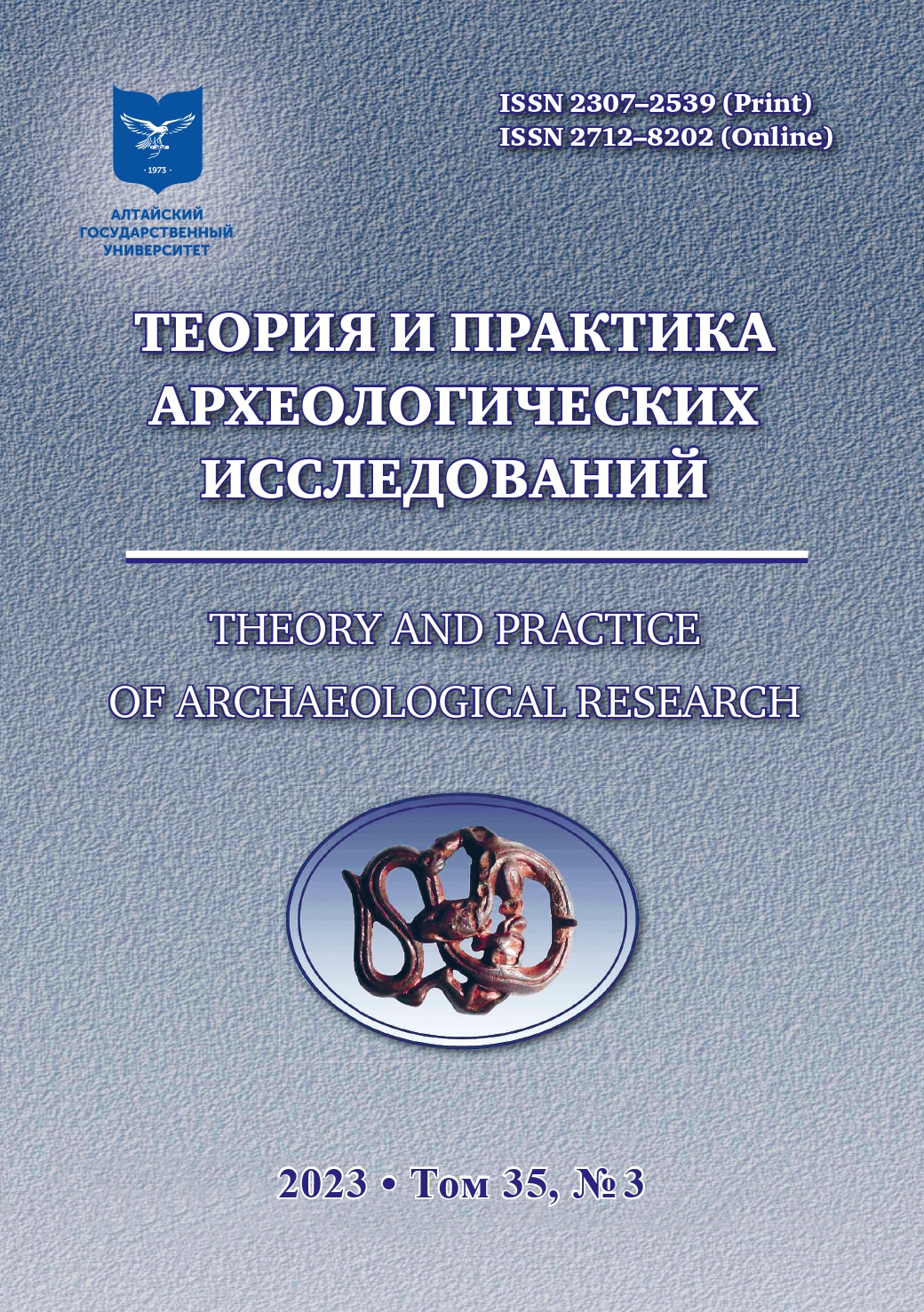BOAT SHAPED HANIWA IN THE HISTORY OF THE DEVELOPMENT OF WATER TRANSPORT ON THE JAPANESE ARCHIPELAGO OF THE KOFUN PERIOD
Abstract
This study considers a special type of archaeological artefacts — boat shaped haniwa, found at the burial complexes of the Kofun period (3rd –7th centuries A.D.) on Japanese archipelago. The settlement of the ancient population in the island territories with mountainous terrain contributed to the use of water transport. At the stage of formation of the political center, water transport became important for operational control and management of remote regions. This aspect of the history of the development of the Japanese archipelago needs a separate consideration, and today it is beginning to be included in the circle of scientific interests of Russian specialists. The development of water transport in the history of Japanese archipelago can be reconstructed of various artefacts, including boat shaped haniwa. In the development of water transport on the territory of the archipelago, on the basis of the methods of construction used, three types of ships are distinguished — dugout boats, semi-structured (block) ships and structure ships. Among semi-structured ships, two subtypes are defined — onesection and two-section. Currently 48 boat shaped haniwa have been found, all of which are of the semistructured (block) type. The sub-types of boat models are distributed roughly evenly. The boat shaped haniwa are models semi-structured (block) vessels and make it possible to reconstruct the construction of small vessels and determine the shipbuilding technology that was widespread during the Kofun period. The boat shaped haniwa are items of funerary equipment and were placed on large chiefdom mounds. They also carried a sacred function, symbolizing the transport for moving the soul of the deceased to the afterlife.
Downloads
Metrics
References
Ivamoto Seiji. Ancient Ships of Japan. Nikhon ko:kai gakkai si = Journal of the Japan Navigation Institute. 2006;6(164):24–46. (In Japanese)
National Historic Sites of Cho:shizuka Kofun and Accompanying Maruyamazuka Confun. Kofu : Yamanasi-ken keikuiinkai, 2008. 190 p. (In Japanese)
Kusaka Masaesi. The Ancient Capital of Naniwa and Osaka. Chiri kagaku = Geographical Research. 1992;47(3):137–142. (In Japanese)
Matsui Tetsuhiro. On the Issue of Dugout Boats. Main Characteristics of Excavated Dugout Boats and Dugout Boats of the Jōmon Period. Kenkyu: kho:koku = Research Reports. 2012;16:42–54. (In Japanese)
Morita Katsuyuki. Ancient Ships — History and Sources. In: Water Communication and Ships of the Kofun Period. Takatsuki : Kinki insatsu senta-, 2014. Pp. 5–12. (In Japanese)
Report on the Archaeological Excavations of the Sites of Nagahara, Uriwari. Osaka: Osaka Cultural Preservation Association, 1994. 215 p. (In Japanese)
Nakanisy Yasuto. Stone Slabs of Kofun Matsuokayama. Tedzukayama daigaku gendaiseikatsu gakubu kiyo: = Bulletin of the Faculty of Contemporary Life of Tezukayama University. 2006;2:69–74. (In Japanese)
Okorokov A.V. One-tree and Block-one-tree Ships. Istoricheskij zhurnal: nauchnye issledovaniya = Historical Journal: Scientific Research. 2012;1(7):27–40. (In Russ.)
Tabarev A.V. Archaeological Data on the Use and Role of Water Transport in the Earliest Cultures of the Japanese Archipelago. Problemy arheologii, etnografii, antropologii Sibiri i sopre-del’nyh territorij: = Problems of Archaeology, Ethnography, Anthropology of Siberia and Neighboring Territories. 2020;26:244–249. (In Russ.)
Tokunaga Hirohito. Study of Fishing Boats of the Ryukyu Group of Islands. Vocational Education through Local Traditional Crafts. Daiiti ko:ge:daigaku kenkyu: kho:koku = Daiichi Institute of Technology Report. 2019;31:85–92. (In Japanese)
Tonomura site, O:ko:jinnotsuka Mound. Iida: The Board of Education of Iida City Pref. Nagano. 2003. 137 p. (In Japanese)
Fujita S. et al. Study of Wooden Products Found on Kofuns of Tawaramoto Village and Identification of Tree Species. Tavaromoto bunkadzai chyo:sa nempo = Reports on Annual Archaeological Research Village of Tavaromoto. 2007;17:87–112. (In Japanese)
Hasizume Asako. Basic Research of Installed Wooden Objects. Tenri daigaku ko:kogaku, mindzokugaku kenkyu:sitsu kie: = Research of the Laboratory of Archaeology and Ethnography of Tenri University. 2004;8:1–23. (In Japanese)
Hozumi Hiromasa. Boat Shaped Haniva and an Ancient Funeral Rite. Mound No. 1 of the Takarazuka Group. Tokio : Sinsensya, 2017. 94 p. (In Japanese)
Copyright (c) 2023 И.С. Гнездилова

This work is licensed under a Creative Commons Attribution 4.0 International License.
Theory and Practice of Archaeological Research is a golden publisher, as we allow self-archiving, but most importantly we are fully transparent about your rights.
Authors may present and discuss their findings ahead of publication: at biological or scientific conferences, on preprint servers, in public databases, and in blogs, wikis, tweets, and other informal communication channels.
Theory and Practice of Archaeological Research allows authors to deposit manuscripts (currently under review or those for intended submission to ABS) in non-commercial, pre-print servers such as ArXiv.
Authors who publish with this journal agree to the following terms:
- Authors retain copyright and grant the journal right of first publication with the work simultaneously licensed under a Creative Commons Attribution License (CC BY 4.0) that allows others to share the work with an acknowledgement of the work's authorship and initial publication in this journal.
- Authors are able to enter into separate, additional contractual arrangements for the non-exclusive distribution of the journal's published version of the work (e.g., post it to an institutional repository or publish it in a book), with an acknowledgement of its initial publication in this journal.
- Authors are permitted and encouraged to post their work online (e.g., in institutional repositories or on their website) prior to and during the submission process, as it can lead to productive exchanges, as well as earlier and greater citation of published work (See The Effect of Open Access).








2.jpg)



